
Syllabus for Groundwater Hyrdology at Queens College
- Subject:
- Hydrology
- Physical Science
- Material Type:
- Syllabus
- Provider:
- CUNY Academic Works
- Provider Set:
- Queens College
- Author:
- Eaton, Tim
- Date Added:
- 01/01/2021

OER created at CUNY for courses in the Physical Sciences
Image by Gerd Altmann from Pixabay

Syllabus for Groundwater Hyrdology at Queens College

The techniques and science of data acquisition and creation for spatial analysis in a geographic information system (GIS); includes field data collection. Students will be instructed in the use GPS devices, mobile GIS, workstation GIS, as well as data from other sources including remotely sensed data.
The full course site is available at https://gep3750.commons.gc.cuny.edu/.

The spring 2017 syllabus for the General Astronomy Course (AST 110), developed as part of the textbook free courseware initiative at Borough of Manhattan Community College.
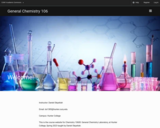
Chemistry is a challenging and often abstract science, but as you progress through this course we
hope you will discover that chemistry is also exciting and that many of the key concepts in chemistry
are both important and relevant to life on earth. Throughout this semester we will provide you with
the basic skills and knowledge to think and feel like a chemist. You will learn that chemistry is
exciting!

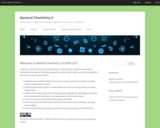
An in-depth introduction to chemical equilibrium, aqueous solution chemistry, thermodynamics, electrochemistry, and kinetics. This course focuses on developing the fundamental principles of thermodynamics and chemical equilibria and the applications of these principles to aqueous solution chemistry.

Chemistry is a challenging and often abstract science, but as you progress through this course we hope you will discover that chemistry is also exciting and that many of the key concepts in chemistry are both important and relevant to life on earth. Throughout this semester we will provide you with the basic skills and knowledge to think and feel like a chemist. You will learn that chemistry is exciting!
This course was created as part of the Open Pedagogy Fellowship, through the Mina Rees Library at The Graduate Center, CUNY.
Read more about the process of course design here: https://gclibrary.commons.gc.cuny.edu/2021/04/29/oer-in-science-catching-up-in-stem/
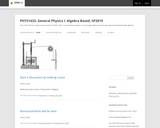
This is the first semester of an introductory one-year college level algebra-based physics course, which covers basic principles of mechanics.
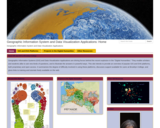
Geographic Information Systems (GIS) and Data Visualization Applications are driving forces behind the recent explosion in the "Digital Humanities." They enable scholars and students alike to ask new kinds of questions, and to illustrate the answers in powerful ways. This site intends to provide an overview of popular GIS and DVA platforms, both proprietary and open access. It summarizes the degree of difficulty involved in using these platforms, discusses support available for users at Brooklyn College, and gives links to training and tutorials freely available on the web.

The online geology lab for community college students was developed by Dr. Rondi Davies, a faculty member at Queensborough Community College, City University New York, during two years of forced online synchronous learning brought on by the COVID-19 pandemic. This open educational resource collects many of Dr. Davies’ favorite open-access materials and supplements them with her own work within a single, cohesive laboratory manual intended for two-year, non-major college students from the New York area.
Dr. Davies wanted to develop labs that were fun, engaging, and that excited students about the subject, were relevant to their lives, helped them to grow as scientists, and even opened their minds to the possibility of a career in STEM and the geosciences. Strategies adopted to achieve these goals include collecting and interpreting data to simulate the scientific process and develop student confidence and self-efficacy, sketching, role-playing as a scientist, and reasoning by analogy to help students feel appreciated and valued.
To enhance relevance and meaning-making, the labs are grounded in the geologic history of New York. Each lab is structured to meet students at their level of knowledge and build on what they know. They follow a 5E instructional approach (Engage, Explore, Explain, Elaborate, Evaluate; Bybee et al., 2006), which is based in educational theory about how students learn and fosters conceptual change. The labs also use anchoring phenomena and modeling to engage students and show their learning.
Each of the twelve labs was designed to be covered in a three-hour class within a 15-week semester. The introductory lab is about observation and interpretation and how the process of science is much like solving a mystery. Mineral resources, plate tectonics, and igneous, sedimentary, and metamorphic rocks provide much of the foundational material. This is followed by more exploratory labs on earthquakes, the glacial and geological history of New York, and climate change. The final lab, an in-person or online field trip guide to the Hall of Planet Earth at the American Museum of Natural History, draws on all the topics covered in previous labs.
Each lab is accompanied by a Teacher’s Guide and an online answer sheet (formatted for the Blackboard learning management system). A multiple-choice format is used for many questions, making the labs easy to grade.
The materials were developed, tested, and refined over two years of synchronous remote learning between 2019 and 2021. Although developed for online learning, they can easily be utilized for in-person classes.
![Hydrocarbon Reaction Experiment [Chemistry]](https://opened.cuny.edu/static/newdesign/images/materials/default-thumbnail-index.png)
The Foundations of Chemistry SCC 110 course is required for LaGuardia's Health Sciences students interested in the Nursing, Dietetic Technician and Veterinary Technician programs. This course has been designated for the Inquiry and Problem Solving competency as well the Digital Communication ability. SCC 110 students will use SCC 110 lecture material and information in the SCC 110 lab manual to perform an electrophilic addition. Students will be able to correlate the organic theory concepts with the experiment by making physical observations (e.g., color changes) when carrying out the lab procedures. The student findings will be synthesized and expressed by making an in-class video and drawing the reaction using chemistry software.
Students, who successfully complete the hydrocarbon reaction lab and produce a corresponding satisfactory digital media report, will ideally have engaged in the assignment for at least three hours in lab followed by an additional 2-3 hours completing the digital components of the lab. The assignment is worth 2.5% of the final grade and is at the midpoint in the core competency for health sciences. This lab assignment was developed in the CTL seminar- Pedagogy of the Digital Ability where assignments were devised in the seminar followed by revisions of the assignment in a charrette format.
LaGuardia's Core Competencies and Communication Abilities
The assignment will enable students to use digital media to explain complex chemistry concepts while improving digital literacy. In more detail, this is shown where SCC 110 students are asked to submit/upload a video of themselves performing an organic chemical reaction and providing audio commentary on the experimental observations with an explanation of the underlying chemistry principles. The second part of the assignment will entail students using chemistry software to draw out the chemical reaction from the lab and uploading the two digital media products in their ePortfolio. The crafted digital report addresses all four dimensions of the digital communication rubric with an emphasis on multimodal communication. It describes both on a macroscopic and microscopic level the step by step organic reaction of an alkene plus bromine to create a haloalkane. Students will be able to use appropriate scientific language to explain the reaction mechanism to the undergraduate scientific student community. The design of the experiment incorporates one of SCC 110's course objective, which is to introduce students to concepts about chemical bonding.
![Hydrophilic Porphyrins based Chemosensors for First Transition Series Metal Ions [Chemistry]](https://opened.cuny.edu/static/newdesign/images/materials/default-thumbnail-index.png)
General Chemistry is a two-semester course (General Chemistry I, SCC 201 and General Chemistry II, SCC 202) required for majors in Biology and Environmental Sciences.
This lab experiment, aligned to LaGuardia Community College‰Ûªs Inquiry and Problem Solving Core Competency and Written Communication Ability was designed for General Chemistry I (SCC 201 Honors) course. Honors courses in LaGuardia emphasize critical thinking, analytical writing, and introduce students to research. This lab experiment provides an opportunity for students to engage in hands-on laboratory work, to develop laboratory skills, and to conduct research in the classroom by using two water soluble porphyrins to detect transition metal ions in a solution and on a paper support. Overall, this experiment was designed to meet the demand for undergraduate research experiences and to engage all the students in addressing a research question or problem that is of interest to the scientific community.
In order to demonstrate their learning, students write a formal lab report which includes an understanding of experiment procedures (methods and techniques), safety hazards, instrumentation, understanding of concepts and theories gained by performing the experiment, collecting data through observation and/or experimentation, interpretation of the data (Ultraviolet-visible spectra), analysis of the data in tables and graphs, and drawing conclusions and perspective from the experiment. The knowledge students gain during this lab experiment will be useful to connect with future chemistry courses and can also be utilized to do research. The lab write-up is deposited for the assessment of the Written Communication Ability to which SCC 201 is aligned.
This experiment also raises awareness about a global concern. Students detect transition metal ions in aqueous solutions by use of porphyrins. Due to rapid growth in technology and industrialization, transition metals are used in large amounts in a variety of electronic products. The improper preservation of the industrial wastes leads to accumulation of these metals into water resources, which can create danger to human health and the environment. Therefore, there is a need to carefully monitor and frequently detect transition metal ions content in the environment.
This lab experiment was implemented in an Honors section of General Chemistry SCC 201 and was worth about 3.5% of the final grade. The students are likely to spend 3 hours completing the experiment in the lab and another 3-4 hours completing the lab write-up.
The Program Goals that this assignment targets:
1. To provide training to the students in various lab techniques and how to utilize these techniques to conduct research.
The Student Learning Objective (s) that this assignment targets:
1. Students will have an enhanced conceptual understanding of the theory to practice relationship and will achieve higher level reasoning skills.
2. Students will be able to develop their practical competence in laboratory work.
3. Students will be able to collect data through observation and/or experimentation, preparation of solutions of known concentration, characterize the compounds by UV-vis spectra, and draw conclusions and perspective of the experiment.
4. Communicate their results through the formal lab report format of: Introduction, Chemicals, Procedure, Data, Discussion and References.
LaGuardia‰Ûªs Core Competencies and Communication Abilities
The Course Objective (s) that this assignment targets:
1. Based on the principles of environmental chemistry, students will be able to detect the transition metal ions using a porphyrin as a sensor and explore the complex connections between chemistry and real world issues.
2. Observe, collect, analyze and interpret experimental data and graph the UV visible spectra using Microsoft Excel.

In this presentation we summarize the lessons learnt through this experience of including live radio programming activities in the context of Macaulay Honors College Seminar III on Science and Technology in New York City. Our presentation falls under the innovation theme and specifically the blended learning opportunities track. The overall goal of the Macaulay Honors College Seminar III is to offer students fundamental scientific and technological knowledge. An essential aspect of our approach was to afford Honors students a real opportunity to interface directly with the actual people involved in science and technology. We arranged for live radio interviews, as well as for pre-recorded ones with -among others- Nobel Laureates, innovators, entrepreneurs, technology-transfer officers from major Universities, and science and technology commentators from the mass media. During the first year of this project, Honors students were assigned pre-existing audio archives of interviews. Students produced a report of 1000-1500 words describing the scientific concepts behind the work of each interviewee. In the second year the class experience was upgraded to live radio programming. Honors students were situated in a green room with laptops and blogged questions in real time to the interviewees. A student representative was the instructor's co-host of the radio program. This programming was realized in the studios of WHCR 90.3 FM, a community radio station broadcasting from the campus of the City College of New York. During the third year of the project the same facilities were used for video-taping interviews among students. We focused on Nobel Laureates who claim City College of New York as their alma mater. We conclude that our approach is sustainable since the available technology allows most students to capture as an audio file or a video file the topic in consideration. Preparing a broadcast entails unique challenges not common in traditional class settings. We also concluded that our approach is measurable since students responsible for a variety of topics were able to follow-up with several interviewees. In some instances students were awarded an internship through the interviewees. This was measurable in that most of this material was archived on respective course websites complete with public commenting and indications for number of hits or Ïnumber of view. We consider our approach scalable due to the ever expanding on-line platforms of most CUNY campuses.

Objectives
Part 1: An Introduction to Data Analysis Using Excel To interpret, summarize and present numerical data using the digital tool Microsoft program Excel. To plot numerical data as a graph and determine an equation of a line. In addition, using the appropriate formatting functions to label your graph and creating a best fit line.
Part 2: Lab Report Writing Using LaGCC Institutional Data To communicate your interpretations of research data. This is done writing discussions and conclusions (using scientific language) and is often accompanied by data tables and graphs. To use your Microsoft Excel graphing skills to interpret, inquire and extrapolate meaning data to support your lab report conclusions To structure your written lab report in the format of: Abstract, Introduction, Material, Methods,Results, Discussion/Conclusion and References

This tutorial was created to accompany the GIS Practicum, a day-long workshop offered by the Newman Library at Baruch College CUNY that introduces participants to geographic information systems (GIS) using the open source software QGIS. The practicum introduces GIS as a concept for envisioning information and as a tool for conducting geographic analyses and creating maps. Participants learn how to navigate a GIS interface, how to prepare layers and conduct a basic geographic analysis, and how to create thematic maps. This tutorial was written using QGIS version 1.5 "Tethys", a cross-platform (Windows, Mac, Linux) desktop GIS software package.

This tutorial was created to accompany the GIS Practicum, a day-long workshop offered by the Newman Library at Baruch College CUNY that introduces participants to geographic information systems (GIS) using the open source software QGIS. The practicum introduces GIS as a concept for envisioning information and as a tool for conducting geographic analyses and creating maps. Participants learn how to navigate a GIS interface, how to prepare layers and conduct a basic geographic analysis, and how to create thematic maps. This tutorial was written using QGIS version 1.8 "Lisboa", a cross-platform (Windows, Mac, Linux) desktop GIS software package.

This tutorial was created to accompany the GIS Practicum, a day-long workshop offered by the Newman Library at Baruch College CUNY that introduces participants to geographic information systems (GIS) using the open source software QGIS. The practicum introduces GIS as a concept for envisioning information and as a tool for conducting geographic analyses and creating maps. Participants learn how to navigate a GIS interface, how to prepare layers and conduct a basic geographic analysis, and how to create thematic maps. This tutorial was written using QGIS version 2.14 "Essen", a cross-platform (Windows, Mac, Linux) desktop GIS software package.

This tutorial was created to accompany the GIS Practicum, a day-long workshop offered by the Newman Library at Baruch College CUNY that introduces participants to geographic information systems (GIS) using the open source software QGIS. The practicum introduces GIS as a concept for envisioning information and as a tool for conducting geographic analyses and creating maps. Participants learn how to navigate a GIS interface, how to prepare layers and conduct a basic geographic analysis, and how to create thematic maps. This tutorial was written using QGIS version 2.18 "Las Palmas", a cross-platform (Windows, Mac, Linux) desktop GIS software package.
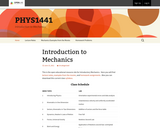
This is the open educational resource site for Introductory Mechanics. Here you will find lecture notes, examples from the movies, and homework assignments. Also you can download this current class syllabus.
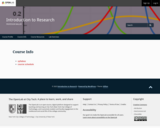
A study of the theoretical and practical application of some basic techniques used in research in the physical sciences. Emphasis is placed on an appreciation for the entire process of scientific practice from proposal through experimentation including poster and oral presentations, to writing a final paper. Includes computer modeling and simulations.